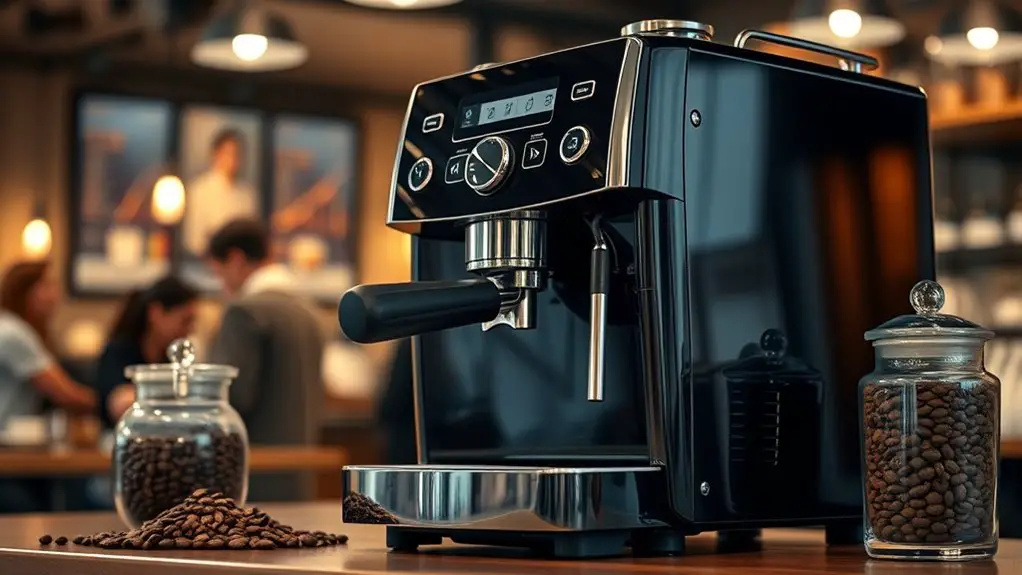Companies design coffee machines for maximum profit by aligning their products with consumer preferences, emphasizing sustainability and ease of use. They leverage technology for efficiency, incorporating features like real-time monitoring and smart connectivity. Innovative design elements, such as user-friendly interfaces and customizable settings, attract buyers. Additionally, they implement cost-reduction strategies like lean manufacturing and strategic sourcing. Finally, building brand loyalty through customer engagement solidifies repeat business. There's much more behind these strategies that you might find intriguing.
Understanding Consumer Preferences
How do you truly gauge what coffee lovers want in a machine? It starts with a deep understanding of consumer preferences, focusing on sustainable materials and a seamless user experience. Coffee enthusiasts today lean towards machines that reflect their values, prioritizing eco-friendly components over traditional materials. They want a device that not only brews a perfect cup but also aligns with their desire for sustainability. Additionally, organic coffee is known for being free from artificial chemicals, which can also influence consumers' choices when selecting a coffee machine. The user experience must be intuitive—machines should be easy to operate and maintain, allowing users to enjoy their coffee without hassle. By analyzing feedback and trends, you can pinpoint features that resonate with your audience, ensuring their freedom to craft their ideal brew while feeling good about their choices.
Leveraging Technology for Efficiency
What if you could enhance not just the brewing process but also the overall efficiency of your coffee machines? By leveraging automation advancements and smart connectivity, you can transform your operations and elevate user experiences. Consider these strategies:
- Implement real-time monitoring for predictive maintenance.
- Utilize machine learning to optimize brewing parameters.
- Integrate smart connectivity for remote control and diagnostics.
- Automate inventory management for seamless supply chains.
- Enable user-friendly interfaces that adapt to preferences.
These innovations not only streamline processes but also enhance profitability. By adopting such technologies, you empower both your business and customers, creating a blend of efficiency and satisfaction that's hard to replicate. Additionally, incorporating customization options can further enhance user satisfaction by allowing individuals to tailor their coffee experience to their unique preferences. Embrace these advancements, and you'll find yourself leading the market in coffee machine design.
Innovative Design Features That Drive Sales
While traditional features have their place, incorporating innovative design elements can markedly boost sales of coffee machines. Think about user-friendly interfaces that simplify the brewing process, making it accessible for all. Aesthetic appeal also plays a significant role; consumers are drawn to visually striking designs that fit seamlessly into their kitchen decor. Additionally, machines that allow for customizable settings can cater to those who prefer bold coffee with its rich flavors and distinct aroma.
| Feature | Impact on Sales | Customer Feedback |
|---|---|---|
| Touchscreen Controls | Enhances user experience | "So easy to use!" |
| Sleek, Modern Design | Attracts design-conscious buyers | "Looks great in my home!" |
| Customizable Settings | Appeals to coffee enthusiasts | "Perfect for my taste!" |
| Eco-Friendly Materials | Attracts eco-conscious consumers | "Love the sustainability!" |
These features can create a compelling product that resonates with your audience.
Cost Reduction Strategies in Production
As you seek to enhance profit margins in the coffee machine market, implementing cost reduction strategies in production becomes essential. By focusing on operational efficiencies, you can markedly lower expenses while maintaining quality. Consider these strategies:
- Supply chain optimization: Streamlining processes to reduce lead times and costs.
- Material sourcing: Identifying cost-effective suppliers without compromising quality.
- Lean manufacturing: Minimizing waste in production to enhance productivity.
- Automation: Investing in technology to reduce labor costs and improve precision.
- Bulk purchasing: Acquiring materials in larger quantities to negotiate better prices.
Building Brand Loyalty Through Customer Engagement
To effectively build brand loyalty in the competitive coffee machine market, companies must prioritize customer engagement as a strategic component of their overall business model. Engaging with your customers through meaningful interactions fosters a sense of community around your brand. By actively soliciting customer feedback, you can refine your products and services to better meet their needs. Implementing loyalty programs not only rewards repeat customers but also creates an incentive for them to share their experiences, further enhancing your brand's reputation. By utilizing data from these engagements, you can tailor marketing efforts and improve product offerings, ensuring you stay relevant in a fast-evolving market. Ultimately, a strong focus on customer engagement transforms buyers into loyal advocates for your brand.
Frequently Asked Questions
What Materials Are Most Commonly Used in Coffee Machine Production?
When considering coffee machine production, you'll find manufacturers often use plastic components for affordability and stainless steel for durability. This strategic choice balances cost-efficiency with quality, fulfilling consumer desires for both reliability and aesthetic appeal.
How Do Companies Test Coffee Machine Prototypes Before Launch?
Imagine testing a smartphone's features. Companies gather user feedback on coffee machine prototypes, making adjustments through prototype iterations. This strategic process guarantees they refine design, functionality, and user experience before launching the final product to the market.
What Role Does Sustainability Play in Coffee Machine Design?
Sustainability in coffee machine design enhances brand appeal. By integrating sustainable materials and eco-friendly features, you not only reduce environmental impact but also attract conscientious consumers who value freedom in making responsible purchasing decisions.
How Do Pricing Strategies Affect Consumer Buying Decisions?
Pricing strategies greatly influence consumer psychology. By implementing pricing tiers, you can appeal to different segments, making products seem accessible while enhancing perceived value. Understanding these dynamics helps you navigate market choices more freely and effectively.
What Are the Most Common Failure Points in Coffee Machines?
Imagine your coffee machine leaking. Common failure modes include clogged filters and faulty pumps, leading to maintenance issues. Understanding these points helps you make informed decisions, ensuring your machine serves you well without constant repairs.
